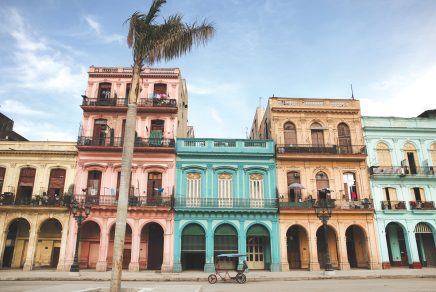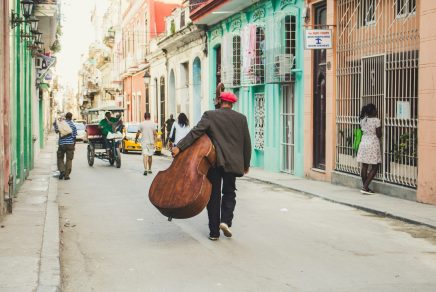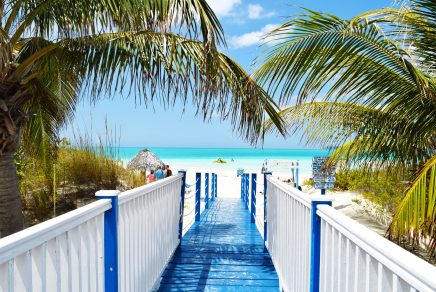Share the article
Cycling in Cuba provides an unforgettable experience, allowing you to fully immerse yourself in the island’s beauty and culture. As you explore the back roads, you’ll discover a Cuba far different from the typical beach resort holiday. Moreover, staying in Casas Particulares and dining in local restaurants offers firsthand insight into the island’s dramatic changes.
No cycling tour of Cuba is complete without venturing into the countryside. The empty roads, shared with horse-drawn carts, reveal unique aspects of Cuban life. Any first trip to Cuba should include a stay in Havana, the ideal starting point for a cycling tour showcasing the island’s best.
Cycle through Havana
Old Havana, bustling with tourists and locals, is ground zero for the changes sweeping the country. Scaffolded buildings are being restored, new hotels are rising, and private residences now rent rooms to tourists. The city buzzes with life: street musicians, artists and the iconic 1950s cars that make Havana a photographer’s dream.
Cycling through Havana means experiencing Plaza de la Revolución, the Prado promenade, the airy Malecón, and the city’s main colonial squares. It’s a feast for the senses and an exciting introduction to Cuba’s culture and history.
lets you experience Plaza de la Revolución, the Prado promenade, the Malecón, and the main colonial squares. It’s a feast for the senses and an exciting introduction to Cuba’s culture and history.
Rural Cuba, the heart of the island
No cycling tour of Cuba is complete without exploring the countryside. Empty roads, shared with horse-drawn carts, offer unique insights into daily Cuban life. This trip will give you an understanding of the challenges facing the island. And also, perhaps more importantly, the pride Cubans have for their country and culture.
Be prepared for hot days. Morning rides are best, with afternoons reserved for cooling off with a piña colada or mojito.
A visit to Cuba’s popular roadside rest areas is a must, where you can enjoy cold piña coladas. For example, Penon Del Fraile is famous for its refreshing piña coladas. Making it a perfect stop after a long ride!
Swimming and strolling in Cienfuegos
As you cycle through swamps, former sugar fields, quaint villages, and pine forests, you’ll visit historic colonial towns like Matanzas, Cienfuegos, and Trinidad. Each day’s ride, ranging from 60 to 80km, takes you along quiet roads with occasional rolling hills—a guide’s euphemism for challenging climbs.
Some of Cuba’s best food is found in paladars, family-run restaurants popping up across the island. A memorable stop was Mily, a tiny paladar in Playa Largo, serving traditional Cuban dishes with pride and care.
End a hot day of cycling with a late lunch and an afternoon swim in the Caribbean Sea at Caleta Buena. This natural rock lagoon, with clear, aqua-blue waters teeming with tropical fish, is perfect for snorkeling, diving, or simply relaxing.
We ended our day in Cienfuegos, a coastal city where families enjoy the cool sea breeze in the main square. Declared a UNESCO World Heritage Site in 2005, Cienfuegos is known for its neoclassical architecture. Finally, head to Villa Largato Paladar for a delicious dinner and end your day at the luxurious Hotel La Union.
Discover the cobbled streets of Trinidad
The 80km ride from Cienfuegos to Trinidad is a cyclist’s dream, filled with rolling hills, bustling villages, and stunning views of the Escambray Mountains. Trinidad, a UNESCO World Heritage Site, is one of the best-preserved cities in the Caribbean, with pastel-colored Spanish colonial architecture that transports you back in time.
In Trinidad, wander the cobblestone streets, shop at open-air markets, relax on the beach, or enjoy activities like horseback riding, sailing, or salsa lessons.
Climb the hills to Santa Clara
On the final day, the 40km ride to Santa Clara will test your climbing skills. The route is mostly uphill, with thrilling descents through villages and pine forests. In Santa Clara, visit the Che Guevara Mausoleum and Museum, which offers an in-depth look at the life of one of Cuba’s most famous heroes.
Is it safe to cycle in Cuba and other useful Cuba bike riding tips
- Join an established tour, like those offered by BikeHike, for a well-organized cycling experience.
- Since Cuba is very hot, plan to cycle in the mornings and reserve afternoons for relaxing.
- Bring essentials: bike gloves, your own bike seat, padded shorts, a water bottle, and a helmet.
- Cuba’s slopes are steep, so practice on similar roads before heading to the island.
- Carry enough cash, as ATMs are scarce in smaller villages.
- Embrace Cuba’s charm and simplicity, knowing you’ll return transformed by its beauty and the warmth of its people.






